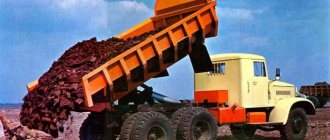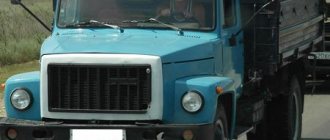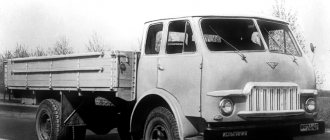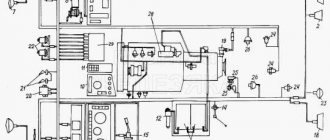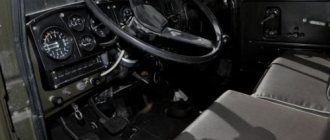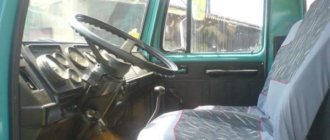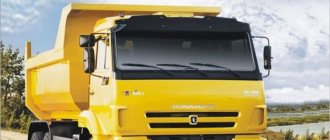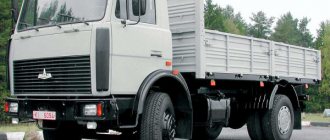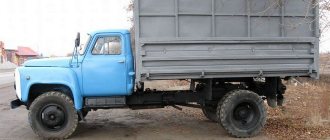The ZIL-MMZ 555 truck was produced on the basis of the 130th model. The dump truck is primarily designed for work in the agricultural sector, but can be used for transporting bulk cargo in construction and other industrial areas. The production of the car began more than fifty years ago, but even now you can find this vehicle in operation. The car is reliable, simple in design, has good maneuverability and capacity. In this material we will consider its characteristics and features.
Device
ZIL 45085 has a 4 by 2 wheel arrangement, which allows the machine to be used on roads with any surface.
The vehicle platform is mounted on a standard two-axle chassis. The drive axle has a single-stage design with a hypoid main gear (gear ratio - 6.33). The machine uses an open cardan drive with an intermediate support and a sliding spline connection. Number of cardan shafts – 2 (balanced, tubular).
Driving is controlled by a 5-speed manual transmission (5 forward speeds, 1 reverse speed) with synchronizers in 2nd, 3rd, 4th and 5th gears. The gearbox is operated using a rocker lever. The gearbox assumes the possibility of power take-off up to 22 kW. The clutch is a single-disc friction device with peripherally located springs. A hydraulic drive with pneumatic booster is used.
The braking system uses drum mechanisms with an expansion cam and 2 internal pads, which are installed on all wheels. The pneumatic brake drive has a separate effect on the elements of the front and rear axles. Automatic braking force control is available for the rear axle.
The ZIL 45085 uses a single-wire electrical system with a voltage of 12 V. The electrical equipment includes a voltage starter with remote control and an electromagnetic traction relay, an alternating current generator with a rectifier and a battery.
In terms of comfort level, ZIL 45085 is far from ideal. The car is equipped with a 2-door 3-seater cabin. For the driver, a separate sprung seat with adjustable rigidity is installed. The seat has adjustments for backrest tilt, cushion and longitudinal position. Conditions for passengers are less comfortable - they are offered a 2-seater seat without adjustments. The cabin is equipped with lighting devices (headlights, turn signals, side lights), a windshield washer and a 3-blade electric wiper.
The steering mechanism is represented by a working pair - a screw with a nut on circulating balls. The steering wheel has a hydraulic booster to make turning easier.
The ZIL 45085 is equipped with a standard dump body with a hydraulic tipping device. The pump and power take-off are switched on remotely from the passenger compartment. The hydraulic distributor is also activated from the cab, but has manual control. Installation of special sides is available to increase the volume of the platform.
In addition to the ZIL 45085 vehicle (ZIL 494560 chassis), the following options are offered:
- differential lock;
- insulating cover;
- liquid pre-heater of the motor PZHB-18;
- rear suspension stabilizer;
- microprocessor ignition system.
Electrical parameters
Models ZIL-MMZ-555 have a clear distinctive feature in comparison with other options. They have rear lights. Their connection diagram is single-wire. The negatively charged terminals of the current source are connected to the vehicle ground.
The nominal voltage in the system reaches 12 V. The electrical equipment of the equipment contains wires with low and high voltage. If they are damaged, they must be replaced. These products cannot be repaired.
If a short circuit occurs, it is recommended to conduct an external visual examination of the circuit. If there is a malfunction, it must be eliminated quickly. To check the electrical equipment in your car, you must use a tool with a test light. It is also necessary to check the condition of the outer insulation coating of the wires; it may be damaged.
Device
The ZIL diesel dump truck on the 130th model chassis is a medium-tonnage vehicle designed for use in construction work, road construction, and agriculture. The car was distinguished by its reliability, maintainability, simplicity of design and comfort in the cabin.
Engine
The base engine installed on almost all modifications of the ZIL-130 was an 8-cylinder, V-shaped, liquid-cooled engine, which was a derated version of the power unit used on the ZIL-111 executive car.
Export versions of the vehicles could be equipped with foreign-made engines:
- Perkins 6.345, 140 hp diesel engine.
- Valmet 411BS, 4-cylinder diesel engine with 125 hp.
- Leyland 0.400, 6-cylinder diesel engine with 135 hp.
For machines intended for use at low temperatures, in areas with cold climates, a pre-heater was installed.
Since 1977, engine modifications have been produced designed to use natural gas as fuel. Such engines were designated ZIL-138.
Hydraulics
The hydraulic system for raising and lowering the body consists of a working fluid tank with a capacity of 17 liters, a mechanical pump driven by the power take-off shaft, and a hydraulic cylinder for lifting the body. The power take-off was driven from the rear gear of the gearbox and provided a power transmission value of 4.5 hp. Hydraulic diagram of the ZIL-MMZ-555 dump truck based on the ZIL-130
1 — axle of the hydraulic lift housing; 2 — hydraulic lift housing; 3 - plunger; 4 - sleeve; 5 — oil tank; 6 - filter; 7 - high pressure tube; 8 — filter safety valve; 9 — bypass tube; 10 - low pressure tube; 11 — lever for switching the power take-off and control valve; 12 — control valve rod; 13 — buffer rod spring; 14 — plunger-spool of the control valve; 15 — control valve; 16 - safety valve; 17 — channel for bypassing oil; 18 — inlet (check) valve; 19 - gear pump
Transmission
The car has a drive to the rear axle, uses a dry single-plate clutch and a mechanical, with two synchronizers in second-third and fourth-fifth gears, a five-speed gearbox with constant mesh gears, with the exception of first and reverse.
The gearbox transmits torque to the rear axle through the driveshaft. The standard model ZIL-130 (collective farmer) and the extended modification use 2 shafts with an intermediate support, which is fixed to the frame. The short-wheelbase modification was equipped with one shaft, which did not require an intermediate support.
Steering
In the steering, which was new for automobile production in the USSR, a hydraulic booster was used, the double vane pump of which was driven into rotation from the engine crankshaft using a belt. Gear shift diagram of the ZIL-130 dump truck
Electrical system
The electrical system is single wire, 12 volt. A battery with a capacity of 90 A/h (6ST-90-EM) was used, the installed alternating current generator 32.3701 provided a maximum value of 60 A. On ZIL-157D engines, a direct current generator G108-V was used.
Brake system
The car has drum brakes on all wheels. They are driven by a pneumatic system. The air supply is stored in a special cylinder under pressure, which is provided by a mechanical compressor driven by a belt drive from the water pump pulley. The productivity of a two-cylinder compressor at 2000 rpm is 220 l/min.
The parking brake is a drum type that blocks the driveshaft.
Important Technical characteristics of the Ural timber truck model range
Body
Depending on the modification, different dump bodies were used. Short-wheelbase modifications of the ZIL-MMZ-555 did not provide for unloading to the sides. The long-wheelbase “agricultural” model 554 had this opportunity.
Gearbox modernization
Over time, a restyled version of the gearbox was released. There was no locking ring, the gear shift knob received an insulating rubber seal, which made it possible to avoid water getting into the block when crossing a ford or during rainstorms.
A special paste made it possible for MMZ OJSC designers to protect manhole covers, gearboxes, as well as the oil sump and some other parts. Ventilation inside the unit is carried out using a special tube, and the crankcase itself is made of high-strength cast iron, which significantly extends its service life. Hydraulic shock absorbers are used on the front axle, and telescopic counterparts are used at the rear.
Modifications
The debut batch of ZIL 4502 rolled off the assembly line in December 1975. A month later, mass production of the car began. Along with the modernization of the ZIL 130 series, the ZIL 4502 also changed. The vehicle was successively produced on the ZIL 130D1-66, ZIL 130D1-76 and ZIL 495810 chassis. At the same time, the characteristics of the vehicle changed:
- load capacity on the ZIL 130D1-66 chassis (January 1975 - April 1977) - 5000 kg;
- load capacity on the ZIL 130D1-76 chassis (April 1977 - December 1980) - 5250 kg;
- load capacity on the ZIL 130D1-76 chassis (December 1980 - January 1986) - 5800 kg;
- load capacity on the ZIL 495810 chassis (January 1986 - 1994) - 6000 kg;
ZIL 4502 was offered in 2 main versions:
- ZIL 45021 – modification not intended for use with a trailer;
- ZIL 45022 is a model with a towing device and the ability to connect a trailer drive system (hydraulic, electric, pneumatic). This dump truck was also equipped with a hydraulic distribution system and a combined type brake valve.
Why are ZIL-130 and MMZ-555 confused? Different cars or modification
Speaking about
the 130th ZIL, many are surprised that sometimes this name is replaced by MMZ and do not understand whether these are really different cars or is it just a modification?
Let's figure it out, but first let us remind you that the 130th ZIL was one of the longest-produced (until 2010) and most mass-produced trucks, which were supplied to all sorts of countries and in various types from fire engines to timber trucks and sewer trucks. One of the most unusual modifications is considered to be the ZIL-MMZ-555
, and in some sources the name ZIL is removed, leaving only MMZ-555, thereby confusing readers and interested parties. They are starting to think that MMZ is an independent model range, but no.
This is still the same ZIL-130, but which received a shortened base compared to the standard 130 flatbed, and also weighed 400 kg less. The chassis was created for it at the ZIL plant, but the body-trough was prepared at the plant in Mytishchi (MMZ). Why a trough?
And look at him. It clearly resembles a trough, which, by the way, was very inconvenient, since the cargo often spilled out and the drivers had to build up the sides with their own hands to avoid this.
Production of this modification began in 1964, although some sources dare to give figures two years earlier or even two years later. (But we can only say that in 1962 the first experimental MMZ-555 was built).
By the way, they were building the 555th (we’ll replace the usual 130th, otherwise it’s already boring)
on the ZIL-130D chassis, and then modernized the superstructure on the ZIL-130D1 chassis. It is characteristic that due to this modification, the load capacity of different versions of the 555 ranged from 4.5 to 5.5 tons.
Technical characteristics:
Power: up to 150 hp. Maximum speed: 90 km/h. Load capacity: up to 5.5 tons. Own weight: 4.5 tons. Fuel per 100 km: 37 liters.
Note that in addition to standard versions of trucks, other modifications of the MMZ-555 were also produced, which differed in engine power and load capacity.
The truck body was considered one of the weak points, since in addition to the fact that the contents often spilled out, it was also of small volume - about 3 m³. These two problems were solved in one way - by adding a side structure. They say that they managed to increase the volume to almost a full 5 m³.
This is why the developers decided not to torment drivers, but to independently produce a new version of the ZIL-MMZ-4502
, which initially had a very comfortable body, with a volume of up to 5.2 m³ and without rashes, and from the point of view of efficiency it was clearly better.
Consumption of 37 liters per 100 km with a volume of 3 cubic meters was not as profitable as the same consumption, but with a volume of 5 cubic meters. We spend the same - we have more.
By the way, the production of 555s continued until 1987, when ZIL switched to creating new modifications, and 555s remained to work on construction sites, public utilities, and some abroad.
Confirmation that this is one of the most successful modifications is that to this day they continue to work successfully in their original form.
Technical characteristics of ZIL-4502 in numbers
- Overall dimensions: length – 5500 mm, width – 2400 mm, height – 2500 mm.
- Wheelbase – 3300 mm.
- Ground clearance – 270 mm.
- Front track width – 1800 mm; rear track - 1790 mm.
- Body, internal dimensions: length – 2600 mm, width – 2300 mm, height – 635 mm; body volume without extension sides – 3.8 cubic meters; with standard extension sides - 5.1 cubic meters. Body lift angle – 50 degrees; lifting time for a loaded body – 15 seconds; empty body lowering time – 20 seconds.
Depending on the modification, the ZIL-4502 dump truck in running order weighs 4750...4825 kg. The total weight of ZIL 45021/ZIL 45022 is 9975...10300 kg. With a maximum body load, the car can accelerate to a speed of 90 km/h.
This dump truck has one fuel tank. It has a volume of 170 liters and is installed under the cargo dump platform, on the left side member.
Specifications
Dimensions of ZIL-4502 and technical characteristics:
- length (with the body folded down) - 6265 mm;
- length when moving - 5490 mm;
- height (to the edge of the visor) - 2540 mm;
- width (along the sides of the body) - 2500 mm;
- approach and departure angles are 38° and 47°, respectively;
- curb weight - 4750-4825 kg;
- load capacity - 5000-6000 kg;
- maximum speed on the highway - 80-90 km/h;
- fuel consumption per 100 body lifts - no less than 6.2 liters;
- hydraulic supply tank capacity - 19 l;
- oil pressure in the hydraulic system - 62-66 kgf/cm²;
- pressure of switching on the safety valve is up to 140 kgf/cm².
The general parameters and performance characteristics of the body depend on the design of the sides. In the standard version, the unit is designed to transport cargo with a volume of 3.8 m³. On the sidewalls there are attachment points for extension metal sides, which were supplied by the factory as a separate order. The use of additional elements created a capacity of up to 5.1 m³. The tailgate is equipped with automatic latches that can be operated manually.
Description of body dimensions and lifting mechanism characteristics:
- length - 2600 mm;
- width - 2300 mm;
- side height (standard) - 635 mm;
- maximum lift angle - 50°;
- body lifting time with a full load is no more than 15 seconds;
- lowering time - 20 seconds.
Device
The ZIL diesel dump truck on the 130th model chassis is a medium-tonnage vehicle designed for use in construction work, road construction, and agriculture. The car was distinguished by its reliability, maintainability, simplicity of design and comfort in the cabin.
Engine
The base engine installed on almost all modifications of the ZIL-130 was an 8-cylinder, V-shaped, liquid-cooled engine, which was a derated version of the power unit used on the ZIL-111 executive car.
Subsequently, from the mid-70s, in order to increase the efficiency of the car, and also taking into account that for some modifications of the car the power of the base engine was excessive, ZIL-157D engines were installed on the ZIL-130K dump truck chassis. This is an inline 6-cylinder engine with 110 hp. In both cases, A-72 gasoline was used, later A-76.
Export versions of the vehicles could be equipped with foreign-made engines:
- Perkins 6.345, 140 hp diesel engine.
- Valmet 411BS, 4-cylinder diesel engine with 125 hp.
- Leyland 0.400, 6-cylinder diesel engine with 135 hp.
For machines intended for use at low temperatures, in areas with cold climates, a pre-heater was installed.
Since 1977, engine modifications have been produced designed to use natural gas as fuel. Such engines were designated ZIL-138.
Hydraulics
The hydraulic system for raising and lowering the body consists of a working fluid tank with a capacity of 17 liters, a mechanical pump driven by the power take-off shaft, and a hydraulic cylinder for lifting the body. The power take-off was driven from the rear gear of the gearbox and provided a power transmission value of 4.5 hp.
Important All-terrain vehicles Lesnik: M, Pro, Vologda, Extreme, M-North, Light, device, drawings, price
Hydraulic diagram of the ZIL-MMZ-555 dump truck based on the ZIL-130
Transmission
The car has a drive to the rear axle, uses a dry single-plate clutch and a mechanical, with two synchronizers in second-third and fourth-fifth gears, a five-speed gearbox with constant mesh gears, with the exception of first and reverse.
This unit was largely innovative for the then automobile industry in the country; it was subject to modernization, during which the driven shaft underwent changes, and its front journal acquired a bearing; changes were made to some other units.
The gearbox transmits torque to the rear axle through the driveshaft. The standard model ZIL-130 (collective farmer) and the extended modification use 2 shafts with an intermediate support, which is fixed to the frame. The short-wheelbase modification was equipped with one shaft, which did not require an intermediate support.
Steering
In the steering, which was new for automobile production in the USSR, a hydraulic booster was used, the double vane pump of which was driven into rotation from the engine crankshaft using a belt.
Gear shift diagram of the ZIL-130 dump truck
Electrical system
The electrical system is single wire, 12 volt. A battery with a capacity of 90 A/h (6ST-90-EM) was used, the installed alternating current generator 32.3701 provided a maximum value of 60 A. On ZIL-157D engines, a direct current generator G108-V was used.
Brake system
The car has drum brakes on all wheels. They are driven by a pneumatic system. The air supply is stored in a special cylinder under pressure, which is provided by a mechanical compressor driven by a belt drive from the water pump pulley. The productivity of a two-cylinder compressor at 2000 rpm is 220 l/min.
The parking brake is a drum type that blocks the driveshaft.
Body
Depending on the modification, different dump bodies were used. Short-wheelbase modifications of the ZIL-MMZ-555 did not provide for unloading to the sides. The long-wheelbase “agricultural” model 554 had this opportunity.
Since 1970, the standard rounded body installed on the ZIL-MMZ-555 model has acquired a visor that protects the cabin from the load falling onto it. The modification received the index ZIL-MMZ-555G.
Dump truck body
The truck in question was produced by the Mytishchi Machine-Building Plant (now OJSC MMZ) based on the ZIL-130. Multiple chassis modifications suggested the use of machines in various industries. During mass production, the cars were constantly improved and refined. For example, the 555 version has a shortened base, which makes it better maneuverable than its competitors. Unloading of cargo is possible only by tilting the working platform back; the ZIL-130 D1 chassis allows it to be aggregated with a tow hitch.
After the seventieth year, the specific rounded body of the dump truck was equipped with a safety visor that protects the driver’s cabin from the load being loaded onto it (model 555G).
Positive and negative properties
An increasing number of car enthusiasts are deciding to buy these trucks. From this product you can make a unique car, since there is the possibility of an optimal upgrade. Among other positive factors, one can note such important indicators as the affordable cost of the vehicle, small dimensions, optimal maintainability and maneuverability of the device. If necessary, you can easily find the necessary parts for repairs. The vehicle’s high cross-country ability is based on the presence of a built-in power steering, and the engine also works perfectly.
Among the disadvantages of the machine are the low speed that all-terrain vehicles are able to develop, an imperfect motor and the carrying capacity is also not a record. Due to the old year of manufacture, parts often fail. Despite the sufficiently comfortable conditions in the cabin, it is slightly inferior by the standards of the present time. The seats can be adjusted, but they are not entirely comfortable for modern drivers. The engine in the cab of ZIL vehicles is inaudible; the vehicle and its main modifications move quietly. Over their 40-year history, these vehicles have proven themselves to be durable and very reliable cargo transport, relatively easy to operate and repair. And now on the roads of the country you can find the ZIL and ZIS, recognizable by everyone, which are purchased as a means of solving a large number of different problems.
Varieties
The ZIL-MMZ-555 power plant has been produced since 1969 and was used in various models of trucks, namely equipment that was widely used in construction, industry, and for transporting goods.
Among the popular types of cars are:
- .Fire engine. It was famous for its high power, maneuverability, and maneuverability.
- Aerial platform. A popular ZIL model that was used in the construction industry.
- Tank. Trucks used to transport liquid products. It carried water, fuel liquids, milk and other products.
- Truck cranes and excavators. The transport was equipped with the necessary elements and installations for simple regulation. They were used to construct high-rise buildings and transport cargo to the upper floors.
- Garbage and snow removal equipment. It had containers for garbage, and there were also buckets for collecting snow. Used in many cities of the USSR.
ZIL-MMZ-555 cars have powerful parameters that are many times superior to those of other power plants of this domestic manufacturer. They are in high demand in Russia, the CIS countries and other countries of the world. Despite the fact that the engine has not been produced for a long time, there are still vehicles on the roads with this power unit, which works properly, covers long distances, and passes in any terrain. Therefore, demand among owners of this type of transport still remains at a high level.
Device
The ZIL diesel dump truck on the 130th model chassis is a medium-tonnage vehicle designed for use in construction work, road construction, and agriculture. The car was distinguished by its reliability, maintainability, simplicity of design and comfort in the cabin.
Engine
The base engine installed on almost all modifications of the ZIL-130 was an 8-cylinder, V-shaped, liquid-cooled engine, which was a derated version of the power unit used on the ZIL-111 executive car.
Subsequently, from the mid-70s, in order to increase the efficiency of the car, and also taking into account that for some modifications of the car the power of the base engine was excessive, ZIL-157D engines were installed on the ZIL-130K dump truck chassis. This is an inline 6-cylinder engine with 110 hp. In both cases, A-72 gasoline was used, later A-76.
Export versions of the vehicles could be equipped with foreign-made engines:
- Perkins 6.345, 140 hp diesel engine.
- Valmet 411BS, 4-cylinder diesel engine with 125 hp.
- Leyland 0.400, 6-cylinder diesel engine with 135 hp.
For machines intended for use at low temperatures, in areas with cold climates, a pre-heater was installed.
Since 1977, engine modifications have been produced designed to use natural gas as fuel. Such engines were designated ZIL-138.
Hydraulics
The hydraulic system for raising and lowering the body consists of a working fluid tank with a capacity of 17 liters, a mechanical pump driven by the power take-off shaft, and a hydraulic cylinder for lifting the body. The power take-off was driven from the rear gear of the gearbox and provided a power transmission value of 4.5 hp.
Hydraulic diagram of the ZIL-MMZ-555 dump truck based on the ZIL-130
Transmission
The car has a drive to the rear axle, uses a dry single-plate clutch and a mechanical, with two synchronizers in second-third and fourth-fifth gears, a five-speed gearbox with constant mesh gears, with the exception of first and reverse.
Important TOP 4 modifications of the PR baler and their technical characteristics
This unit was largely innovative for the then automobile industry in the country; it was subject to modernization, during which the driven shaft underwent changes, and its front journal acquired a bearing; changes were made to some other units.
The gearbox transmits torque to the rear axle through the driveshaft. The standard model ZIL-130 (collective farmer) and the extended modification use 2 shafts with an intermediate support, which is fixed to the frame. The short-wheelbase modification was equipped with one shaft, which did not require an intermediate support.
Steering
In the steering, which was new for automobile production in the USSR, a hydraulic booster was used, the double vane pump of which was driven into rotation from the engine crankshaft using a belt.
Gear shift diagram of the ZIL-130 dump truck
Electrical system
The electrical system is single wire, 12 volt. A battery with a capacity of 90 A/h (6ST-90-EM) was used, the installed alternating current generator 32.3701 provided a maximum value of 60 A. On ZIL-157D engines, a direct current generator G108-V was used.
Brake system
The car has drum brakes on all wheels. They are driven by a pneumatic system. The air supply is stored in a special cylinder under pressure, which is provided by a mechanical compressor driven by a belt drive from the water pump pulley. The productivity of a two-cylinder compressor at 2000 rpm is 220 l/min.
The parking brake is a drum type that blocks the driveshaft.
Body
Depending on the modification, different dump bodies were used. Short-wheelbase modifications of the ZIL-MMZ-555 did not provide for unloading to the sides. The long-wheelbase “agricultural” model 554 had this opportunity.
Since 1970, the standard rounded body installed on the ZIL-MMZ-555 model has acquired a visor that protects the cabin from the load falling onto it. The modification received the index ZIL-MMZ-555G.
Description ZIL MMZ-555
The ZIL 555 dump truck appears to be one of the modifications of the 130th model of this series, popular among consumers. Its mass production began in 1969, but due to its long service life, maintainability and other advantages, the 555 model is still actively used to this day.
When developing the modification, the frame of the 130th model, shortened by 1060 mm, which was equipped with 4 transverse connections, was taken as a basis. ZIL MMZ-555 is designed for operation in temperate climates, but the automaker also presented tropical versions, distinguished by a high-power cooling system.
Among the distinctive features of this model it is worth mentioning:
- long service life;
- excellent performance characteristics for the year of manufacture;
- lack of a towing hook on the rear cross member;
- reduced cardan transmission due to the reduced base;
- reinforced springs, allowing to increase the suspension life.
History[ | ]
The first work on a new truck, intended to replace the serial ZIS-150, began at the plant in 1953 under the leadership of chief designer of trucks Anatoly Mavrikievich Krieger, Georgy Aleksandrovich Festa was appointed lead designer, the design of the car was ultimately determined by the leading artist plant T. P. Kiseleva. Initially the project bore the names ZIS-125, ZIS-150M, and was later renamed ZIL-130.
- In December 1956, the first prototype was released.
- In 1959, the machine was first shown at the All-Union Agricultural Exhibition.
- In February 1961, the design assignment was finally approved.
- In September 1962, the first five ZIL-130s were sent into trial operation at the Yaroslavl Tire Plant.
- In 1963, cars began to roll off the factory assembly line.
- On October 1, 1964, after a general reconstruction of the plant, mass serial production of the car began; in December of the same year, production of the previous model, the ZIL-164A (modernization of the ZIS-150), ceased.
- In June 1974, the millionth ZIL-130 was manufactured.
- In August 1982 - the two millionth ZIL-130.
- Since January 1, 1986, subsequent upgrades of the ZIL-130 received the new designation ZIL-431410, but there were no fundamental design changes, the car remained the same in appearance and the new designation was used only in official documentation.
- In total, before production ceased in December 1994, the ZIL automobile plant produced 3,366,503 ZIL-130 trucks (not counting those manufactured at other enterprises of the USSR automotive industry).
ZIL-130 was also produced on a small scale at other factories in the country.
- In July 1975, the Chita car assembly plant began producing the ZIL-130 (until December 1994, together with the main plant, 3,383,312 copies were manufactured).
- At the ZIL-130 units, the Kutaisi Automobile Plant (KAZ) produced KAZ-608, KAZ-608V trucks (engine, gearbox and axles were used).
- From 1995 to 2014, the latest modifications of the ZIL-130 were produced at the Ural Automotive Plant (UAMZ), a former branch of ZIL that specialized in ZIL-131N military trucks. There, the car received a new index UAMZ-43140 or AMUR-43140, various engines were used in different modifications, including D-245.9E2 diesel engines; In addition to the standard one, cabins and tail surfaces from ZIL-131 and ZIL-433360 were often installed.
Where can you buy ZIL and its cost
Since such a vehicle is no longer produced by the manufacturer, it can be purchased exclusively through private classifieds sites, such as Avito and numerous analogues. This does not mean that the consumer will not be able to purchase a new truck without an impressive mileage, since such models are often found at military facilities in a mothballed state.
The cost of such models depends on many factors, including:
- technical condition of the unit;
- year of issue;
- modification of the model.
Also, prices may vary depending on the region of sale, which is advisable to take into account when planning to save on your purchase. Often, companies specializing in used equipment also sell mothballed models. Prices for Zil 157 vary from 100 to 230 thousand rubles.
Buying from preservation
When planning to purchase a car of this kind, you need to be extremely careful about its technical condition, since prolonged downtime often leads to numerous problems in various components of the car.
Particular attention should be paid to the engine of this car, since it quite often malfunctions when not used. It is worth remembering that the military institutions themselves wrote off these vehicles a long time ago, which is why their condition directly depends on the storage conditions of the current owners of the car
Prices and analogues
The production of dump trucks ceased in 1987, but the vehicles are found on the secondary market. The cost of a truck in good technical condition is about 200 thousand rubles. There are cars costing 50-70 thousand rubles that do not have documents or state registration. 1:43 scale models are available for collectors. The cost of such a miniature dump truck is 1-2 thousand rubles. A direct analogue of the vehicle is the ZIL-MMZ-4502 truck or its modernized version MMZ-4505.
